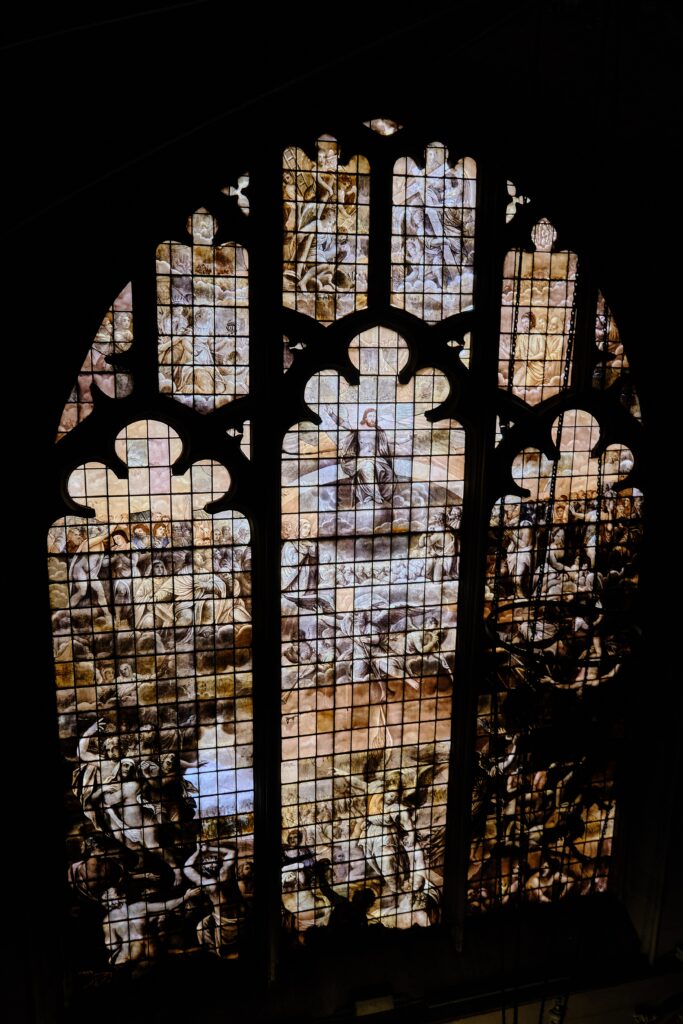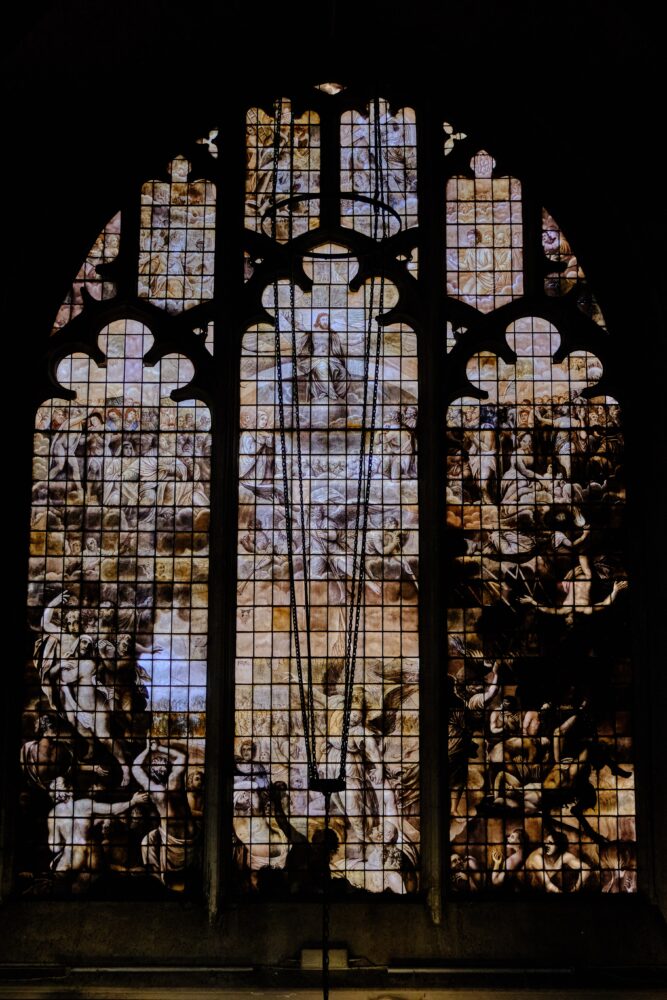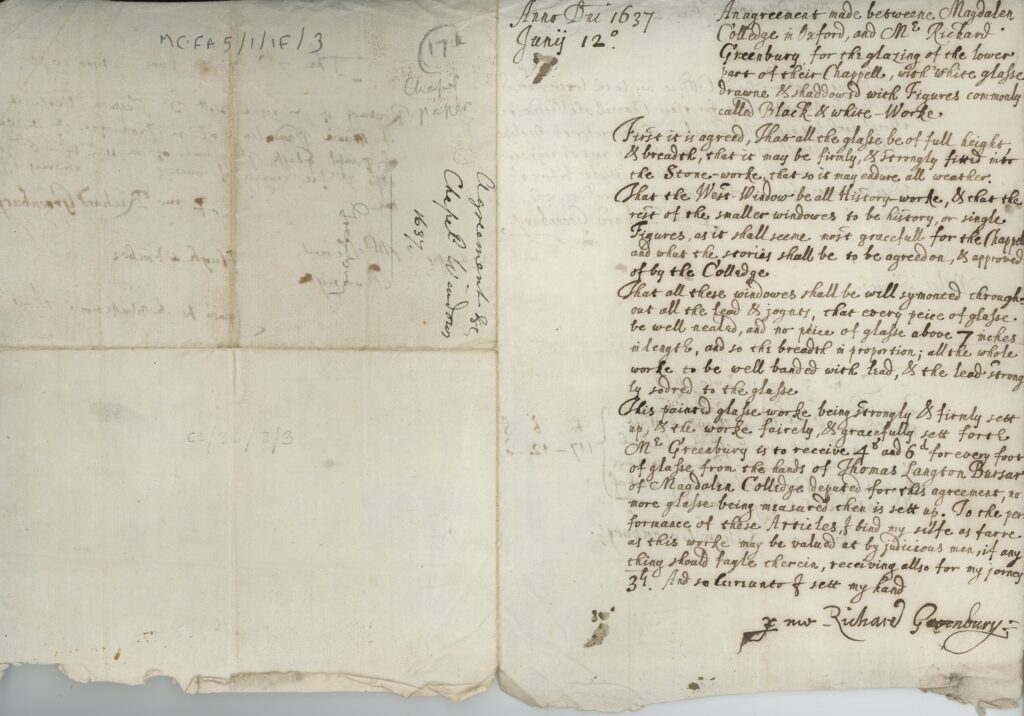


A goldsmith, painter, and glazier, Richard Greenbury was a canny choice of artist to paint the West Window. Goldsmithery involved techniques that were highly transferable to glasswork, particularly enamelling. Although glass painting had been practised in England since the twelfth century, an expert craftsman such as the London-based Greenbury harnessed the latest developments in its technology.


When Greenbury signed the agreement for the West Window in the summer of 1637, the narrative subject was still ‘to be agreed upon and approved of by the college.’ Even after the Last Judgement was selected, there remained the task of scaling up the design from Sadeler’s print and dividing the composition to match the architectural setting. Translating an ovular print into a vertical orientation, Greenbury shifted the figures slightly to fit three evenly spaced, foiled arches divided by two mullions, not to mention into six symmetrical geometric subdivisions above. Certain figures had to be moved, vertically or horizontally, and well as forward or backward in space.
For example, Greenbury’s trumpeting angels in the centre of the composition have become larger in comparison to those in Sadeler’s engraving, while the Virgin Mary shifts away from Christ so that she sits in parallel with St. John the Baptist. This change was not necessitated by spatial constraints, but it makes for a more traditional balancing of the Deesis group, an iconography with roots in the Byzantine era.


This sheet records the agreement and expense receipts for the chapel’s painted glass, assigned to the London-based artist Richard Greenbury. Written by Greenbury and dated 12 June 1637, the document stipulates that the work be executed in ‘black and white,’ a feature that distinguishes Magdalen’s West Window from other monumental painted glass designs of the period. While such monochrome work simplified the task of an artist working from a black and white print, the college fellows likely made this decision for a different reason. This colour scheme had the advantage of matching new black and white marble set into the floor of the chapel, not to mention the design of the college’s coat of arms.
Beyond colour, there were immediate concerns that the window be sturdy and weather resistant. The document includes repeated indications that the glass must be ‘firmly and strongly fitted into the stonework’ and that ‘these windows shall be well symented [cemented] throughout all the led and joynes.’


A receipt written inside the folded sheet reveals that Greenbury gained access to fine Normandy glass for the project thanks to a loan of 40 pounds. The initial agreement indicated that the college bursar would pay no more than 4 shillings and 8 pence ‘for every foot of glass’ that Greenbury worked, and the comparatively large expense of 40 pounds for raw materials was loaned directly from the president, who must have been keen to see the Last Judgement illuminated through the famously transparent Normandy glass.
![Magdalen College Archives, FA5/1/1F/6: Account of money spent in making models for the chapel windows [...] and carriage of ‘Mr. Greenburie’s Booke’ to and from London, c. 1640](https://lastjudgementwindow.magd.ox.ac.uk/wp-content/uploads/2023/11/III-Painting-the-Window-4th-image-804x1024.jpg)
![Magdalen College Archives, FA5/1/1F/6: Account of money spent in making models for the chapel windows [...] and carriage of ‘Mr. Greenburie’s Booke’ to and from London, c. 1640](https://lastjudgementwindow.magd.ox.ac.uk/wp-content/uploads/2023/11/III-Painting-the-Window-4th-image-804x1024.jpg)
A later, undated bill records three expenses accrued by Greenbury while producing Magdalen’s painted glass windows. This document gives insight into the transit of materials from his London workshop, as well as the coordination between artisans with different forms of expertise.
The first two expenses show two pounds paid to a glazier and a mason for ‘making of the modells,’ followed by a six pence fee for transporting these models to Greenbury’s London workshop. The third expense lists nine pence for transporting Greenbury’s book (perhaps containing drawings of the window designs) ‘to and fro from London.’ The bill’s reverse indicates it is to be paid directly by the college president.